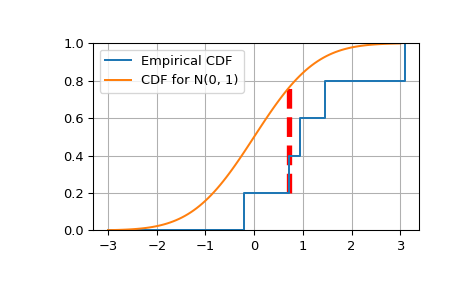scipy.special.smirnov¶
-
scipy.special.smirnov(n, d) = <ufunc 'smirnov'>¶ Kolmogorov-Smirnov complementary cumulative distribution function
Returns the exact Kolmogorov-Smirnov complementary cumulative distribution function,(aka the Survival Function) of Dn+ (or Dn-) for a one-sided test of equality between an empirical and a theoretical distribution. It is equal to the probability that the maximum difference between a theoretical distribution and an empirical one based on n samples is greater than d.
- Parameters
- nint
Number of samples
- dfloat array_like
Deviation between the Empirical CDF (ECDF) and the target CDF.
- Returns
- float
The value(s) of smirnov(n, d), Prob(Dn+ >= d) (Also Prob(Dn- >= d))
See also
smirnoviThe Inverse Survival Function for the distribution
scipy.stats.ksoneProvides the functionality as a continuous distribution
kolmogorov,kolmogiFunctions for the two-sided distribution
Notes
smirnovis used by stats.kstest in the application of the Kolmogorov-Smirnov Goodness of Fit test. For historial reasons this function is exposed in scpy.special, but the recommended way to achieve the most accurate CDF/SF/PDF/PPF/ISF computations is to use the stats.ksone distrubution.Examples
>>> from scipy.special import smirnov
Show the probability of a gap at least as big as 0, 0.5 and 1.0 for a sample of size 5
>>> smirnov(5, [0, 0.5, 1.0]) array([ 1. , 0.056, 0. ])
Compare a sample of size 5 drawn from a source N(0.5, 1) distribution against a target N(0, 1) CDF.
>>> from scipy.stats import norm >>> n = 5 >>> gendist = norm(0.5, 1) # Normal distribution, mean 0.5, stddev 1 >>> np.random.seed(seed=233423) # Set the seed for reproducibility >>> x = np.sort(gendist.rvs(size=n)) >>> x array([-0.20946287, 0.71688765, 0.95164151, 1.44590852, 3.08880533]) >>> target = norm(0, 1) >>> cdfs = target.cdf(x) >>> cdfs array([ 0.41704346, 0.76327829, 0.82936059, 0.92589857, 0.99899518]) # Construct the Empirical CDF and the K-S statistics (Dn+, Dn-, Dn) >>> ecdfs = np.arange(n+1, dtype=float)/n >>> cols = np.column_stack([x, ecdfs[1:], cdfs, cdfs - ecdfs[:n], ecdfs[1:] - cdfs]) >>> np.set_printoptions(precision=3) >>> cols array([[ -2.095e-01, 2.000e-01, 4.170e-01, 4.170e-01, -2.170e-01], [ 7.169e-01, 4.000e-01, 7.633e-01, 5.633e-01, -3.633e-01], [ 9.516e-01, 6.000e-01, 8.294e-01, 4.294e-01, -2.294e-01], [ 1.446e+00, 8.000e-01, 9.259e-01, 3.259e-01, -1.259e-01], [ 3.089e+00, 1.000e+00, 9.990e-01, 1.990e-01, 1.005e-03]]) >>> gaps = cols[:, -2:] >>> Dnpm = np.max(gaps, axis=0) >>> print('Dn-=%f, Dn+=%f' % (Dnpm[0], Dnpm[1])) Dn-=0.563278, Dn+=0.001005 >>> probs = smirnov(n, Dnpm) >>> print(chr(10).join(['For a sample of size %d drawn from a N(0, 1) distribution:' % n, ... ' Smirnov n=%d: Prob(Dn- >= %f) = %.4f' % (n, Dnpm[0], probs[0]), ... ' Smirnov n=%d: Prob(Dn+ >= %f) = %.4f' % (n, Dnpm[1], probs[1])])) For a sample of size 5 drawn from a N(0, 1) distribution: Smirnov n=5: Prob(Dn- >= 0.563278) = 0.0250 Smirnov n=5: Prob(Dn+ >= 0.001005) = 0.9990
Plot the Empirical CDF against the target N(0, 1) CDF
>>> import matplotlib.pyplot as plt >>> plt.step(np.concatenate([[-3], x]), ecdfs, where='post', label='Empirical CDF') >>> x3 = np.linspace(-3, 3, 100) >>> plt.plot(x3, target.cdf(x3), label='CDF for N(0, 1)') >>> plt.ylim([0, 1]); plt.grid(True); plt.legend(); # Add vertical lines marking Dn+ and Dn- >>> iminus, iplus = np.argmax(gaps, axis=0) >>> plt.vlines([x[iminus]], ecdfs[iminus], cdfs[iminus], color='r', linestyle='dashed', lw=4) >>> plt.vlines([x[iplus]], cdfs[iplus], ecdfs[iplus+1], color='m', linestyle='dashed', lw=4) >>> plt.show()

